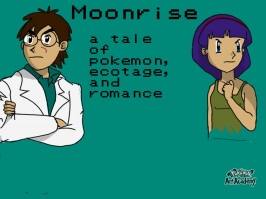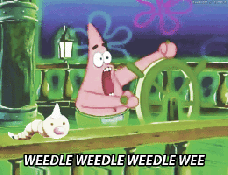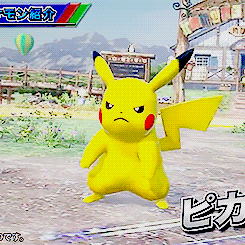After a week-long hiatus in which I tried and failed to catch up on some reading, we’re back with a little bit more about how the show is addressing the idea of difference.
Episode 1.29, “Sparks fly for Magnemite,” is another one of those episodes that has a theme but doesn’t ever clearly articulate it. It’s a weird quirk of the show; they’re obviously doing “Ash learns a lesson” type episodes, but without clean resolutions. I like it, because it doesn’t spell things out, but it can get a little confusing because it doesn’t spell things out. Episode 1.29 is exploring the way that our characters think of the agency and liveliness of inorganic matter. The two new pokémon we learn about in this episode are both “inorganic pokémon.” What the characters learn by the end of the episode is that even inorganic matter has agency–i.e., tendencies, preferences, and the ability to act in ways contrary to human desires and plans.
Gringey City
Passing through Gringey City, Ash and co. are disgusted by the pollution. It’s an industrial town with no obvious living quarters. Ash remarks that it’s a “really weird city. Lots of factories but no people.” Brock, a.k.a. Exposition Man, explains that “Pollution ruined the air and the water here.” While there, Pikachu falls ill, sparking at the cheeks and running a fever, and the city’s power shuts off because 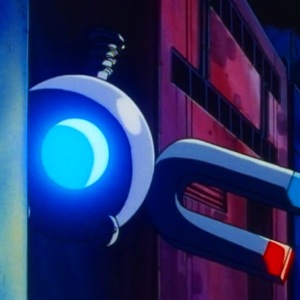 of a concentrated attack by sludge-pokémon called grimer, threatening the lives of the (disturbingly numerous) pokémon in the IC unit of the local Pokémon Center.
of a concentrated attack by sludge-pokémon called grimer, threatening the lives of the (disturbingly numerous) pokémon in the IC unit of the local Pokémon Center.
After some legitimately creepy, Alien-like action in the dark powerplant, stalked by grimer in the air vents, the gang is cornered by the violent, murderous pollution pokémon. They only survive with the help of the metallic magnemites, one of whom has taken a liking to Pikachu.
A few things are going on. While the cause of the grimers’/muk’s violence isn’t clear, their active animosity toward the humans is obvious. Grimer’s Pokédex entry says that their origin is pollution and that they’re “Born from sludge.” Perhaps it means they breed in sludge, but even their bodies are more or less sentient poison glop. The grimers, born from pollution, embody the way that the waste humans produce can escape their control and affect the world in new ways. The products of our own consumption can, in turn, try to consume us. “Inorganic” does not equal dead or even controllable.
can escape their control and affect the world in new ways. The products of our own consumption can, in turn, try to consume us. “Inorganic” does not equal dead or even controllable.
A bit of theory
Jane Bennett might call this an example of vibrant matter. Bennett is the main thinker of the philosophy of vital materialism, outlined in her book Vibrant Matter. Vibrant materialism expands the definition of agency and life, saying that agency and a liveliness are present in any “creative not-quite-human force capable of producing the new” (118).1 There’s a lot of background before she gets to this point–she draws on thinkers from Lucretius (b. ca. 99 B.C.) to Spinoza (b. 1632) to Deleuze/Guatarri (contemporary scholars)–but the gist of it is that human lives interact with and are influenced by a lot of non-human elements, including inorganic elements themselves. The non-human world, even what we and the characters see as the “dead” world of stuff, is a far more active and vital force than we often understand.
The agency and desire of the inorganic in the pokéverse is brought up very explicitly when a lone magnemite shows attraction to Pikachu. Misty comments that it seems to be in love–the magnemite even blushes and orbits Pikachu like a lovesick satellite. Brock is doubtful: “If it were an animal pokémon I’d understand,” he mansplains, “but how can an inorganic pokémon fall in love with an electric rodent?”
love–the magnemite even blushes and orbits Pikachu like a lovesick satellite. Brock is doubtful: “If it were an animal pokémon I’d understand,” he mansplains, “but how can an inorganic pokémon fall in love with an electric rodent?”
The magnemite’s attraction is so strong that it and its fellow magnet ‘mon show up to save Pikachu and the others from the murderous grimer. Magnemite changes its mind, though, when Pikachu loses some electric charge in the battle. Brock then has to wonder if magnemites, inorganic though they are, may be capable of desire and preference, musing, “Maybe magnemite fall in and out of love just like humans do?”2 While the grimers embody the perils of ignoring the vitality and capacities for resistance inherent in matter, the magnemites shows the possible alliances we can make with matter. Because of one magnemite’s attraction, all the magnemites came to save them. The gang owes their lives to vibrant matter.
Accepting difference
The episode is also about accepting other-ness. Brock immediately assumes that because magnemite is inorganic that it has no subjectivity. He accepts that it’s alive, but questions its ability to have intentions and desires. He has to admit, though, that just because Pikachu is warm-blooded/cute and magnemite is metallic/less expressive, magnemite is no less an agentive being than Pikachu.
Interestingly, Misty is the one who, from the first, accepted that the magnemite might have the capacity to want and to feel. Misty also was the only one able to feel pity for the tentacool/tentacruel from the start. Misty, the one who was tormented, doubted, written-off by her sisters as pretty useless and therefore unworthy of their kindness, once again shows herself to be the one most able to see the beauty and the person-ness of weird, unlikely, not-conventionally-cute others.3
TL;DR: The grimer and magnemite show us and the characters how things we sometimes think of as simply objects or dead matter can actually have tendencies, abilities, properties, or vitality that forces us to consider them in a new way. Misty seems to be the most able to see the agency of things and beings that are different.
1. One of the chapters of Bennett’s book actually discusses, at length, a recent massive power outage in the U.S., a crisis that highlighted the emergent properties of a complex system made up of things “from a quirky electron flow and a spontaneous fire to members of Congress who have a neoliberal faith in market self-regulation.” ↩
2. Why this is in question I’m not sure, since inorganic ‘mon are obviously no less active than more familiar “animal pokémon.” Brock once ran a rock-type gym. Rock and metal are both inorganic materials, so does this imply that Brock has always assumed that his geodude and his onyx were just lumps of active granite without desires or affection? Maybe it’s just an example of the species discrimination our culture practices when we decide we can’t eat dogs but can eat pigs. ↩
3. This does not stop Misty from being a total butt to the psyduck she unwillingly acquired a few episodes before. She calls the poor thing “useless” more than once, yelling at it because it isn’t a very good battler. I’ll definitely call her out on this at a later point… ↩



 , by assuming the role of the Maiden and playing out her plot every year, troubles this fetishizing view, making the figure of the Maiden far more creepy and less virginal/desirable than Brock, James, and the unnamed painter want to think.
, by assuming the role of the Maiden and playing out her plot every year, troubles this fetishizing view, making the figure of the Maiden far more creepy and less virginal/desirable than Brock, James, and the unnamed painter want to think. characteristic of ghostly ‘mon–that they don’t fit. They’re uncanny, shifting, gaseous. They’re incomprehensible, as we see in episode 23. Traveling to Lavender Town, Ash finds a haunter and a gengar, ghastly’s later evolutionary stages, and when he whips out his pokédex it can tell him only that “Ghost pokémon are in a vapor form. Their true nature is shrouded in mystery.” Confronted with haunter and gengar specifically, the ‘dex simply IDs them, notes that they’re “gasous pokémon,” and says, “no further information available.” If the Pokédex, representative of all academic, codified (and misleadingly coercive?) pokémon knowledge, has no further info, there has to be a culture-wide ignorance about these ‘mon. This fits with the way the ghastly enjoys inhabiting folk tales–maybe they’re deemed “ghostly” because they’re too elusive for more academic, skeptical research to get hard info on them.
characteristic of ghostly ‘mon–that they don’t fit. They’re uncanny, shifting, gaseous. They’re incomprehensible, as we see in episode 23. Traveling to Lavender Town, Ash finds a haunter and a gengar, ghastly’s later evolutionary stages, and when he whips out his pokédex it can tell him only that “Ghost pokémon are in a vapor form. Their true nature is shrouded in mystery.” Confronted with haunter and gengar specifically, the ‘dex simply IDs them, notes that they’re “gasous pokémon,” and says, “no further information available.” If the Pokédex, representative of all academic, codified (and misleadingly coercive?) pokémon knowledge, has no further info, there has to be a culture-wide ignorance about these ‘mon. This fits with the way the ghastly enjoys inhabiting folk tales–maybe they’re deemed “ghostly” because they’re too elusive for more academic, skeptical research to get hard info on them.
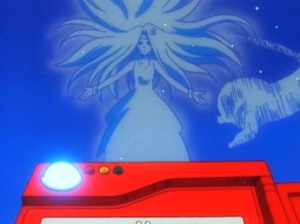 so are we sure that these ghost “pokémon” should be in the same order of beings as critters like pidgey? Maybe they’re really more like non-human spirits rather than non-human animals. Is “pokémon” just a really flexible term that applies to elementally powerful non-humans? Our own term, “animal,” is no less rigorous, so this is possible.
so are we sure that these ghost “pokémon” should be in the same order of beings as critters like pidgey? Maybe they’re really more like non-human spirits rather than non-human animals. Is “pokémon” just a really flexible term that applies to elementally powerful non-humans? Our own term, “animal,” is no less rigorous, so this is possible.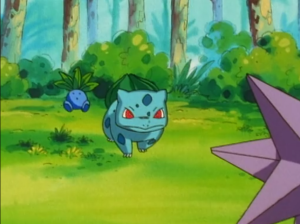
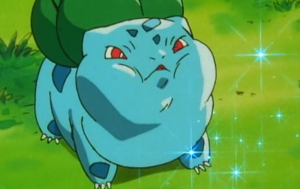
 Melanie is kind but also the most dangerous character we’ve encountered. Team Rocket is more sinister and malevolent, but Melanie is the only one who’s actively sought to harm anyone. Her drastic measures underscore her desperation to create a place where no other humans can safely come.
Melanie is kind but also the most dangerous character we’ve encountered. Team Rocket is more sinister and malevolent, but Melanie is the only one who’s actively sought to harm anyone. Her drastic measures underscore her desperation to create a place where no other humans can safely come.
